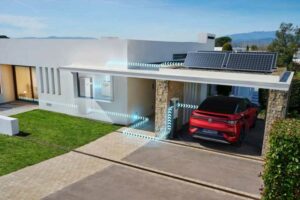VW Finally Offers Bidirectional Charging In Europe. What About The U.S.?

Volkswagen has debuted bidirectional charging technology on the first ID electric vehicles—but only in Europe for now.
The technology is available with the vehicle-to-home (V2H) function on all new Volkswagen ID models equipped with the 77-kilowatt-hour (usable) battery pack and running ID Software 3.5 or higher. Models that fit the bill include the facelifted ID.3, ID.4, ID.5, ID.7, and ID.Buzz.
The automaker said it will also activate the function for vehicles that are already in customer hands as soon as these EVs receive the ID Software 3.5 via an update.
Volkswagen claims it is one of the first providers of a bidirectional charging solution based on the CCS (Combined Charging System) DC charging standard, which is predominant in Europe. Other automakers, including Nissan, Hyundai, Kia, Genesis, BYD, and MG already offer bidirectional charging on the continent.
We asked Volkswagen of America if bidirectional charging is coming to the U.S. as well, and it looks like the company is at least considering the possibility. “We are investigating this for the U.S.,” a VW spokesperson told InsideEVs. As a reminder, the German automaker had promised that bidirectional charging would launch as early as summer 2022.
Gallery: Volkswagen bidirectional charging debuts in Europe
According to the automaker’s European press release, compatible Volkswagen ID models will be able to use the bidirectional charging function to both power a home and store excess electricity generated by a home’s photovoltaic system.
The automaker estimates that a house can be supplied with solar power stored in the vehicle battery over several cloudy days or in the evening when the sun has set and the photovoltaic system is no longer supplying electricity.
The system also enables owners of VW ID vehicles to charge their cars precisely when there is a lot of renewable energy available, thanks to clever electricity tariffs and algorithms.
In addition to powering homes, in the future VW ID electric vehicles will also be able to feed power that they do not need into the electricity grid (V2G) to stabilize it.
Volkswagen is demonstrating the bidirectional charging technology at a pilot project in Sweden in which an entire housing estate is supplied with EVs and the necessary charging infrastructure, including a home power station and an integrated Home Energy Management System (HEMS) supplied by Volkswagen partner HagerEnergy GmbH.
Using this infrastructure, customers can cover as much of their household electricity consumption as possible with their photovoltaic system.
So how does this work? Like a dynamic extension of the home storage system, essentially. The ID EV is activated by the home power station when the home storage system requires additional energy. After the home storage system is recharged, the vehicle stops transferring energy and enters standby mode. The EV is only activated again when additional energy is required.
Initially, eligible Volkswagen ID models in Europe are only compatible with the S10 E COMPACT series DC home power station from HagerEnergy GmbH. Other home power stations will become compatible with a bidirectional charging station at a later date.
It’s worth noting that bidirectional charging stops when the vehicle’s high-voltage battery reaches 20% state of charge to ensure that it remains ready to be driven.
Source: Read Full Article
